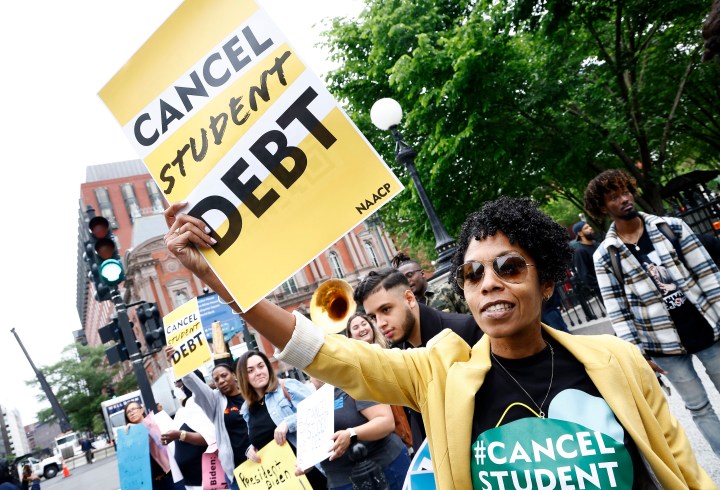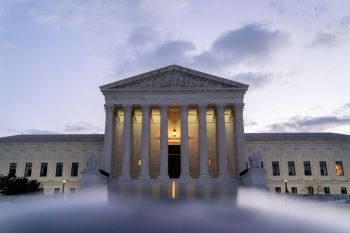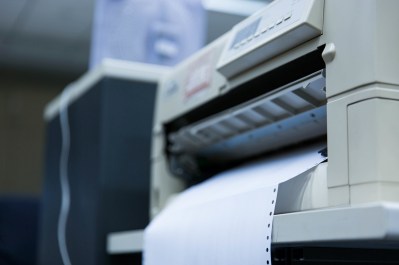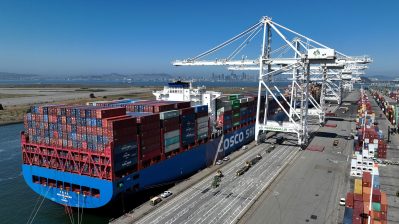
What would happen if everyone just stopped paying their student debt?
Share Now on:
What would happen if everyone just stopped paying their student debt?

This is just one of the stories from our “I’ve Always Wondered” series, where we tackle all of your questions about the world of business, no matter how big or small. Ever wondered if recycling is worth it? Or how store brands stack up against name brands? Check out more from the series here.
Listener Esan Robinson asks:
What would happen if everyone/ the majority of people with the student loan debt stopped paying?
U.S. student loan borrowers collectively hold about $1.8 trillion in debt. That amount of money is preventing many of them from paying off other debt, owning a home, saving for retirement or starting a family.
To address this burden, President Joe Biden announced that up to $10,000 in student loan debt would be canceled for individuals who make less than $125,000 a year and families making less than $250,000. Those who are Pell Grant recipients would get an additional $10,000 waived.
But there are two legal challenges against the plan that have gone all the way up to the Supreme Court, which heard oral arguments on his debt relief plan late last month.
Payments will resume 60 days after the program gets implemented or litigation gets resolved, according to the U.S. Department of Education. If neither happens by June 30, payments will restart 60 days after that date.
Here’s what happened when people did stop paying during the pandemic
Experts say that the suspension of student loan payments at the start of the pandemic helped out borrowers at a time of economic upheaval. The demand for certain services like travel and leisure plummeted and businesses across the country shuttered, leading millions of Americans to be laid off. In April 2020, the unemployment rate reached 14.7%, the highest it had been since the Great Depression.
So the federal government’s moratorium at the time “was certainly welcome relief,” said Michael Jones, an associate professor of economics at the University of Cincinnati.
People were able to accumulate more savings due to the pause along with other factors, like stimulus checks, said Amy Li, an assistant professor of educational policy studies at Florida International University.
“I think people were building up a nice nest egg during that time period, and the student loan pause really helped contribute to that,” Li said.
But now, Jones said “the justification” for the pause is less strong than it was at the start of the pandemic, since we have low unemployment and the economy has been adding jobs.
What would happen if some or all loans were forgiven?
Nick Hillman, a professor at the University of Wisconsin-Madison’s School of Education, said he thinks Biden’s forgiveness program would be a net positive.
“Our student loan repayment system has been shut off for three years and it’s already a pretty rusty machine in the first place,” Hillman said.
Once we resume those payments, it’ll leave many people worse off, he explained.
“So cancellation would help in that transition period,” he added.
He also noted that it would also help those who have defaulted on their loans. “It would really help a lot of truly struggling borrowers who have really no other form of relief,” he said.
Jones said some economists are concerned Biden’s student relief program will fuel inflation, which surged between 2021 and 2022 and reached 40-year highs.
Former Treasury Secretary Larry Summers, for example, tweeted: “Student loan debt relief is spending that raises demand and increases inflation. It consumes resources that could be better used helping those who did not, for whatever reason, have the chance to attend college.”
However, analysts on Wall Street say the amount of debt wiped out through the relief program ($400 billion) would not give a big boost to people’s incomes in aggregate, and would thus have a small impact on inflation. At the time, they said that the effects on inflation would be further reduced when some people do have to start repaying their balances in January (a deadline that has since been extended).
Longer-term, Jones said that the prospect of forgiving student debt has some economists concerned over the issue of “moral hazard,” or the notion that students might make riskier choices if they think their debt will end up being forgiven.
We see that concept being talked about in the recent Silicon Valley Bank crisis, where experts pointed out that covering a bank’s deposits could encourage them to invest in riskier assets.
“If the Education Department continues to make new student loans after a round of mass loan cancellation, borrowers will be justified — and probably correct — in assuming that another bout of forgiveness will happen sometime in the future,” wrote one Forbes contributor. “In economic terms, the expected cost of borrowing will be lower. Therefore, students will borrow more, and colleges will charge higher tuition.”
But some experts, like Kate Padgett Walsh of Iowa State University, say this could be addressed by not just canceling debt, but also implementing programs that minimize future borrowing.
Walsh, writing for The Conversation, said that New Mexico, for example, has offered free tuition scholarships at public colleges and universities.
What would happen if everyone just decided to stop paying?
Student loans cannot be discharged in bankruptcy, so they would still follow you around, pointed out Li of Florida International University.
She said interest on your loans would accrue in the event that you just decided to stop paying. And she noted it would have an impact on your income-to-debt ratio, which lenders take into consideration.
Hillman pointed out that following the Great Recession, some organizers have tried to push for debt strikes, in which people would stop paying their student loan bills.
But, he said, the federal government has a way of penalizing you. It can, for example, garnish your wages and withhold your tax refunds if you default on your student loans.
If everyone stopped trying to pay down the nation’s $1.8 trillion in student debt, Hillman said it’s tough to predict where any extra funds people have would go. But he said perhaps that money would go toward retirement savings or homeownership — or maybe just expenses that people need to get by in their everyday lives.
However, it won’t address the root issues in our higher education system. He thinks one solution would be to provide free college tuition for everyone.
“The cost of attending college is so high, and oftentimes, it’s the nontuition expenses. For example, room and board. It’s just expensive to live in America,” Hillman said. “Even if everybody says, ‘I’m not paying ever again,’ it doesn’t change those underlying structures.”
There’s a lot happening in the world. Through it all, Marketplace is here for you.
You rely on Marketplace to break down the world’s events and tell you how it affects you in a fact-based, approachable way. We rely on your financial support to keep making that possible.
Your donation today powers the independent journalism that you rely on. For just $5/month, you can help sustain Marketplace so we can keep reporting on the things that matter to you.


















